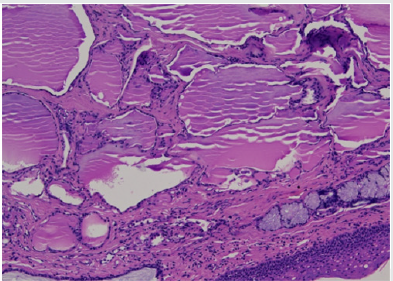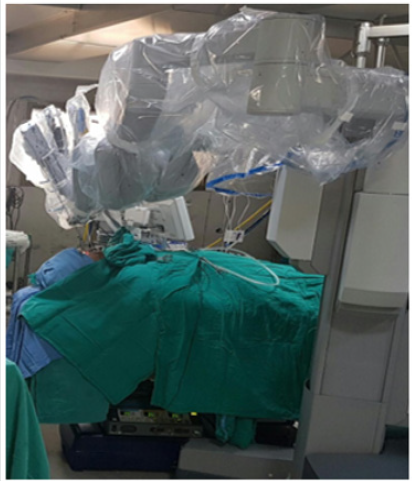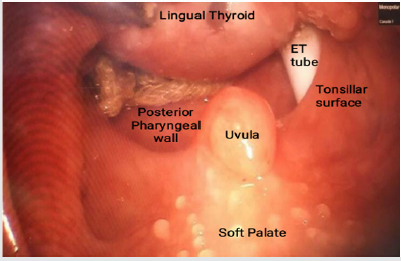
Lupine Publishers Group
Lupine Publishers
Menu
ISSN: 2641-1709
Case Report(ISSN: 2641-1709) 
Transoral Robotic Resection of Lingual Thyroid Volume 4 - Issue 2
Kalpana Nagpal*, Noor Ul Din Malik, Shaili Priyamvada, and Kamal Goyal
- Department of ENT, Indraprastha Apollo Hospital, India
Received: March 02, 2020; Published: March 10, 2020
Corresponding author: Kalpana Nagpal, Department of ENT, Head & Neck Surgery and Robotic Surgery, Indraprastha Apollo Hospital, Sarita Vihar, New Delhi, India
DOI: 10.32474/SJO.2020.04.000181
Abbreviations: TORS: Transoral Robotic surgery; TSH: Thyroid Stimulating Hormone; US: Ultra Sonography
Introduction
Surgical removal of ectopic lingual thyroid is indicated in symptomatic patients or in cases of suspected malignancies. An external approach is most often used but is associated with morbidity and visible scar on cervical region. In this case we utilized Transoral Robotic surgery [TORS] to excise ectopic lingual thyroid tissue. Ectopic thyroid refers to the presence of thyroid tissue in locations other than the normal anterior neck region between the second and fourth tracheal cartilages. It is the most frequent form of thyroid dysgenesis, accounting for 48-61% of the cases [1]. Lingual thyroid is a rare developmental anomaly originating from aberrant embryogenesis during the passage of the thyroid gland through the neck. Prevalence of this condition is reported to be between 1 per 100,000-300,000 persons and occur one in 4,000- 8,000 patients with thyroid disease [2]. To date, about 500 cases have been reported in the English literature mainly from Europe, Asia and America, with a small number of reports coming from Africa. Sixty-five to eighty percent of cases occurred in females [2]. Although it is difficult to detect asymptomatic thyroid ectopy, postmortem studies have suggested that 7-10% of adults may harbor asymptomatic thyroid tissue along the path of the thyroglossal duct [3]. In 1869, Hickman reported the first case of ectopic thyroid tumour of the base of the tongue, pressing down the epiglottis on the larynx and causing death by suffocation sixteen hours after birth [4]. In 1999, da-Vinci robot was developed by intuitive company in USA. It contains high magnification 3-D endoscope, endo-wristed instruments with motion scaling and tremor filtration function that help surgeons to perform endoscopic surgery with more precision, dexterity and control. conventional transoral approach has the disadvantages of limited exposure and difficulty in manipulation and hemostasis [5]. In this paper we report a case of 16 years old lady from Nepal who presented to our hospital with choking symptoms which are more during night since years. She was treated as an asthmatic and had no improvement with bronchodilators. She was referred to our center for further evaluation to rule out any ENT cause. Fiberoptic laryngoscopy lead to provisional diagnosis of lingual thyroid. She underwent excision of ectopic thyroid tissue by Da Vinci robotic surgical system. Histopathological examination confirmed lingual thyroid (Figure 1).
Figure 1: Photomicrograph of histology section, Hematoxylin Eosin stain, 10 X magnification, showing covering of normal squamous epithelium of tongue, with many variable sized colloids filled thyroid follicles in the subepethelium.

Case Report
A 16-year-old female presented with dyspnoea especially at night and foreign body sensation throat. The patient also had complaints of dysphagia. She had no history of either past or present thyroid disease. Upon examination, the patient presented a solid, pink, spherical mass, covered with intact mucosa, located at the base of the tongue. Examination of the neck revealed no palpable thyroid gland in the normal pre-tracheal position and no cervical adenopathy. Thyroid hormone tests showed normal thyroid-stimulating hormone (TSH) concentrations and normal FT3 and FT4 concentrations. Patient was clinically euthyroid. Ultrasonography (US) revealed a mass 5x4cm in size with distinct margins restricted to the base of the tongue and absence of the thyroid gland. A thyroid scan with technetium Tc-99m sodium was performed showing marked isotope uptake in the area of the tongue and no uptake in the neck (Figure 2).
Figure 2: Photomicrograph of histology section, H & E stain, 20 X, with similar features as in slide 1.

Method
Patient was taken up for transoral robotic surgical excision of
lingual thyroid tissue under
general anesthesia. The da Vinci Si surgical system (Intuitive
Surgical, Sunnyvale, CA) used.
a) Patient position is like Rose’s position of tonsillectomy.
Neck is extended by sandbag under the shoulders and the head
is supported on a ring.
b) Painting & draping done.
c) Docking of the robot done. Mass base of tongue visualized
using 30 degree up endoscope. 4mm instruments used for
dissection.
d) Maryland dissector at left hand side and spatula tip
electro-cautery at right hand side.
e) Resection carried out from the anterior border of the
lingual thyroid along the capsule
f) of ectopic thyroid tissue. Mass excised in toto. Hemostasis
confirmed.
g) Undocking of robot done. GA withdrawn.
h) Excised tissue sent for histopathological examination.
i) Pt. kept in hospital overnight for observation. No
postoperative complications.
j) Post operatively substitutive thyroid hormone
replacement therapy was given.
Gross description: Multiple mucosa covered tissue pieces altogether measure 5x2x0.5cm. No ulcer or mass lesion is identified on the surface. The cut surface shows a brownish, colloid like appearance.
Microscopic description: Sections show unremarkable stratified squamous epithelial lining. The subepithelial stroma shows islands of normal thyroid follicles and few seromucinous salivary glands, with mild lymphoid cell infiltrate. There is no evidence of malignancy (Figure 3).
Conclusion: Excised swelling base of tongue - LINGUAL THYROID.
Results
TORS of ectopic lingual thyroid tissue was successfully performed with excellent functional outcomes and with decreased operating time than conventional tongue base surgeries. Less than 5 ml blood loss during surgery and stay in the hospital was less than 24 hours (Figure 4).
Discussion
Lingual thyroid is reported to be a rare congenital anomaly
in the population. Asymptomatic ectopic thyroid tissue becomes
symptomatic in periods of puberty, pregnancy, menopause,
inflammation, and stress. Thyroid requirement increasing in these
periods leads TSH level to increase and hypertrophy in the thyroid
gland [8]. Approach to lingual thyroid tissue may vary according
to clinical findings, but it is still debatable. Although asymptomatic
cases can be followed without management for probable
complications, in symptomatic cases, there are alternative treatment
methods. Even though thyroid suppressive treatment conducted
with the administration of exogenous thyroid hormone is a method
that can be preferred in patients with minimal symptoms, it is
not preferred in that it requires long term treatment. Radioactive
iodine treatment and surgery are other treatment alternatives. As
it is in a region difficult to access, open surgical approaches have
been used in surgical treatment [9]. These surgical approaches
may lead morbidity rates to increase according to the method
used since they require lip, tongue, and mandibular splitting or
lateral, suprahyoid pharyngotomy and long operation times and
feeding with nasogastric tube, they run the risk of the development
of suprahyoid pharyngotomy, hospitalization is prolonged, and
there are skin scars. In order to avoid these morbidities, transoral
resection techniques including Co2 laser, electrocautery, and
harmonic technologies are used.
Terris et al. [10] reported that transoral minimal invasive
lingual thyroid resection decreased morbidity and duration of
hospitalization compared to other open approaches. Coblation
assisted lingual thyroid and lingual tonsil resection techniques
were used and successful results were reported [11-13]. Leitzbach
et al. [12] reported successful results and low complication rates in
108 patients undergoing coblation assisted resection due to tongue
root and lingual tonsil hypertrophy. However, transoral resection
techniques have limited point of view and lead to difficulty in
resection owing to difficulty in manipulation, which restricts
their use [6]. Studies have demonstrated that as the size of the
mass increases, transoral respectability of the mass decreases.
The basic principles of avoiding complications in transoral tongue
root resections are careful dissection in accordance with imaging
methods and adequate anatomic evaluation in order to prevent
lingual artery injury [14]. Transoral robotic surgery decreases the
technical difficulties encountered in other transoral approaches
in that it has a three-dimensional larger point of view, and
manipulation is easier thanks to robotic instruments, leading to
its larger use in oropharyngeal and tongue root operations [7].
Transoral robotic surgery is used in many different regions in
surgical otolaryngology [15,16]. Three robotic arms, 0-degree and
30-degree high definition and 3-dimensional video instruments
make it possible to overcome restriction of visualization of regions
with difficult access and difficulty of manipulation. Lingual thyroid
excision using this method has been described in previous studies
[17,18]. The absolute local contraindication is related to the difficult
exposition of the oropharynx, due to a limited opening of the mouth
or the patient’s habitus. TORS for treatment of ectopic lingual goiter
is feasible, requires a short learning curve, and appears to be safe
[19]. In addition, the robotic surgery also has been adopted to do
esthetic neck surgery with better cosmetic outcomes by hiding the
scar [20].
Conclusion
TORS assisted excision of ectopic lingual thyroid is minimally invasive, feasible method. It is a safe technique with minimum morbidity and decreased operative time. In experienced hands it should be offered as valid treatment for this pathology. Studies with larger case series and longer duration of follow-up are required in order to reach a definitive conclusion on this issue.
References
- Felice Md, Lauro Rd (2004)Thyroid Development and Its Disorders: Genetic and Molecular Mechanisms. Endocrine Reviews 25(5): 722-746.
- Yoon JS, Won KC, Cho iH, Lee Jt, Lee HW (2007)ClinicalCharacteristics of Ectopic Thyroid in Korea. Thyroid 17(11): 1117-1121.
- Sauk JJ (1970) Ectopic Lingual Thyroid. J Pathology 102(4): 239-245.
- Hickman W (1869) Congenital Tumor of the Base of the Tongue, Pressing Down the Epiglottis on the Larynx and Causing Death by Suffocation Sixteen Hours after Birth. TransPathol Soc Lond 20: 160-161
- ManWei Hua, Wen-Chun Lin, Chen-Chi Wang (2019) Triple Ectopic Thyroid Excision by Robotic Surgery via Trans-Oral and Post-Auricular Approach Report of a Case. Annals of Clinical Case Report4: 1-4.
- Dziegielewski PT, Chau JKM, Seikaly H, Allegretto M, Barber B, et al. (2011) Lingual Thyroid in Adults: Management Algorithm Based on Swallowing Outcomes. Journal of Otolaryngology-Head and Neck Surgery 40(1): 19-26.
- O'Malley BW, Weinstein GS, Snyder W, Hockstein N (2006) Transoral Robotic Surgery (TORS) for Base of Tongue Neoplasms. The Laryngoscope116(8):1465-1472.
- Thomas G, Hoilat R, Daniels JS, Kalagie W (2003) Ectopic Lingual Thyroid: ACase Report. International Journal of Oral & Maxillofacial Surgery32(2):219-221.
- Atiyeh BS, Abdelnour A, Haddad FF,Ahmad H (1995) Lingual Thyroid: Tongue-Splitting Incision for Transoral Excision. The Journal of Laryngology and Otology109(6): 520-524.
- Terris DJ, Seybt MW, Vaughters RB (2010) A New Minimally Invasive Lingual Thyroidectomy Techniqu. Thyroid20(12): 1367-1369.
- Bock JM, Trask DK (2008) Coblation Assisted Lingual Tonsillectomy for Dysphagia Secondary to Tongue Base Hypertrophy. Annals of Otology, Rhinology and Laryngology117(7): 506-509.
- Leitzbach SU,Bodlaj R, Maurer JT, Hörmann K, Stuck BA (2014) Safety of Cold Ablation (coblation) in the Treatment of Tonsillar Hypertrophy of the Tongue Base. European Archives of Oto-Rhino-Laryngology271(6):1635-1639.
- Rabiei S, Rahimi M, Ebrahimi A (2010) Coblation Assisted Excision of Lingual Thyroid. Indian Journal of Otolaryngology and Head & Neck Surgery62(2): 108-110.
- ElifErsoyCallJoglu, KazJmBozdemir, Bulent Ulusoy, TolgaOguzhan M (2015) Case Report Lingual Thyroid Excision with Transoral Robotic Surgery. Hindawi Publishing Corporation Case Reports in Otolaryngology 2015:p.4.
- Lin HS, Rowley JA, Folbe AJ, Yoo GH, Badr MS, et al. (2015) Transoral Robotic Surgery for Treatment of Obstructive Sleep Apnea: Factors Predicting Surgical Response.The Laryngoscope 125(4): 1013-1020.
- Ansarin M, Tagliabue M, Chu F, Zorzi S, Proh M, et al. (2014) Transoral Robotic Surgery in Retro styloid Parapharyngeal Space Schwannomas.Case Reports in Otolaryngology.
- Teo EH, Toh ST, Tay HN, Han HJ (2013) Transoral Robotic Resection of Lingual Thyroid: Case Report. The Journal of Laryngology & Otology127(10): 1034-1037.
- Howard BE, Moore EJ, Hinni ML (2014) Lingual Thyroidectomy: The Mayo Clinic Experience with Transoral Laser Microsurgery and Transoral Robotic Surgery. Annals of Otology, Rhinology & Laryngology123(3): 183-187.
- Pellini R, Mercante G, Ruscito P, CristalliG, Spriano G (2013) Ectopic Lingual Goiter Treated by Transoral Robotic Surgery. Acta Otorhinolaryngological Italica 33(5): 343-346.
- Ji YB, Song CM, Bang HS, Park HJ, Lee JY, et al. (2017) Functional and Cosmetic Outcomes of Robot-Assisted Neck Dissection by a Postauricular Facelift Approach for Head and Neck Cancer. Oral Oncol70:51-57.

Top Editors
-

Mark E Smith
Bio chemistry
University of Texas Medical Branch, USA -

Lawrence A Presley
Department of Criminal Justice
Liberty University, USA -

Thomas W Miller
Department of Psychiatry
University of Kentucky, USA -

Gjumrakch Aliev
Department of Medicine
Gally International Biomedical Research & Consulting LLC, USA -

Christopher Bryant
Department of Urbanisation and Agricultural
Montreal university, USA -

Robert William Frare
Oral & Maxillofacial Pathology
New York University, USA -

Rudolph Modesto Navari
Gastroenterology and Hepatology
University of Alabama, UK -

Andrew Hague
Department of Medicine
Universities of Bradford, UK -

George Gregory Buttigieg
Maltese College of Obstetrics and Gynaecology, Europe -

Chen-Hsiung Yeh
Oncology
Circulogene Theranostics, England -
.png)
Emilio Bucio-Carrillo
Radiation Chemistry
National University of Mexico, USA -
.jpg)
Casey J Grenier
Analytical Chemistry
Wentworth Institute of Technology, USA -
Hany Atalah
Minimally Invasive Surgery
Mercer University school of Medicine, USA -

Abu-Hussein Muhamad
Pediatric Dentistry
University of Athens , Greece

The annual scholar awards from Lupine Publishers honor a selected number Read More...






